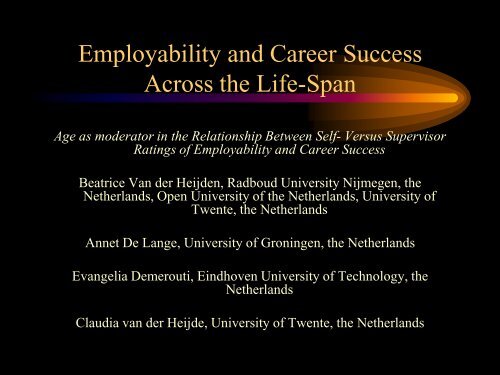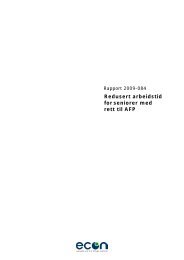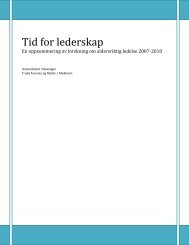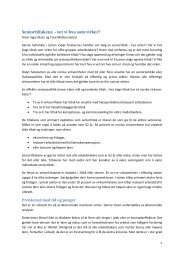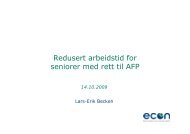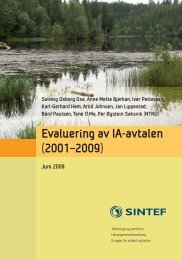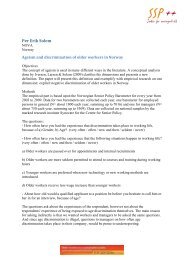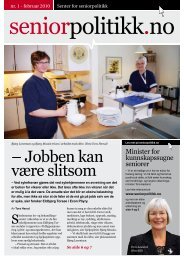Professor Beatrice v.d. Heijden - Older workers in a sustainable ...
Professor Beatrice v.d. Heijden - Older workers in a sustainable ...
Professor Beatrice v.d. Heijden - Older workers in a sustainable ...
You also want an ePaper? Increase the reach of your titles
YUMPU automatically turns print PDFs into web optimized ePapers that Google loves.
Employability and Career Success<br />
Across the Life-Span<br />
Age as moderator <strong>in</strong> the Relationship Between Self- Versus Supervisor<br />
Rat<strong>in</strong>gs of Employability and Career Success<br />
<strong>Beatrice</strong> Van der <strong>Heijden</strong>, Radboud University Nijmegen, the<br />
Netherlands, Open University of the Netherlands, University of<br />
Twente, the Netherlands<br />
Annet De Lange, University of Gron<strong>in</strong>gen, the Netherlands<br />
Evangelia Demerouti, E<strong>in</strong>dhoven University of Technology, the<br />
Netherlands<br />
Claudia van der Heijde, University of Twente, the Netherlands
Introduction<br />
• Employability (or career potential) is seen as a<br />
prerequisite for career success (cf. Van der Heijde<br />
& Van der <strong>Heijden</strong>, 2006).<br />
• Far-reach<strong>in</strong>g changes <strong>in</strong> the workforce (age<strong>in</strong>g and<br />
dejuvenization) that necessitate further empirical<br />
research on age<strong>in</strong>g and careers.<br />
• Career management only possible given a<br />
thorough understand<strong>in</strong>g of what constitutes one‟s<br />
employability.
Aims of the Study<br />
• Firstly, to test the operationalization of<br />
employability, and to <strong>in</strong>vestigate whether the<br />
factor structure for self-reported versus<br />
supervisor-rated employability is similar across<br />
two age groups of <strong>workers</strong> („youngsters‟ versus<br />
„over-forties‟).<br />
• Secondly, we exam<strong>in</strong>e the predictive validity of<br />
employability <strong>in</strong> the light of objective career<br />
success, us<strong>in</strong>g two sources of raters (employees<br />
and their immediate supervisors).
Aims of the Study<br />
• Thirdly, this study aims to exam<strong>in</strong>e whether<br />
age of the employee moderates the<br />
relationship between self- and supervisor<br />
rat<strong>in</strong>gs of employability, on the one hand,<br />
and objective career success, on the other.
Employability<br />
• “The cont<strong>in</strong>uous fulfill<strong>in</strong>g, acquir<strong>in</strong>g or<br />
creat<strong>in</strong>g of work through the optimal use of<br />
competences” (Van der Heijde & Van der<br />
<strong>Heijden</strong>, 2006).
Career Success<br />
• “The accumulated <strong>in</strong>teraction between a<br />
variety of <strong>in</strong>dividual, organizational and<br />
societal norms, behaviors, and work<br />
practices” (Boudreau, Boswell, & Judge,<br />
2001), and refers to real or objective, and<br />
perceived or subjective accomplishments of<br />
<strong>in</strong>dividuals <strong>in</strong> their work lives.”
Multi-Rater or Multi-Source Rat<strong>in</strong>gs<br />
• For example, from supervisors, peers,<br />
subord<strong>in</strong>ates, and customers, <strong>in</strong>stead of<br />
rely<strong>in</strong>g on appraisals from a s<strong>in</strong>gle source.<br />
• The rationale beh<strong>in</strong>d this is that different<br />
evaluation perspectives offer unique and<br />
valuable <strong>in</strong>formation, and thus <strong>in</strong>cremental<br />
validity to the assessment of <strong>in</strong>dividual<br />
performance.
Hypotheses<br />
• We expect an equivalent factor structure of<br />
the employability construct among the rater<br />
groups (employees and supervisors), and we<br />
advocate the comparability of the different<br />
rater group scores. Moreover, <strong>in</strong> l<strong>in</strong>e with<br />
previous research, we expect a similar<br />
factor structure across different age groups<br />
of <strong>workers</strong> (Hypothesis 1).
Hypotheses<br />
• Employability is positively associated with<br />
career success (Hypothesis 2 for self-rated,<br />
and Hypothesis 3 for supervisor-rated<br />
employability).
Hypotheses<br />
• Age moderates the relationship between<br />
supervisor rat<strong>in</strong>gs of employability and<br />
objective career success. More specifically,<br />
we expect a stronger relationship between<br />
supervisor-rated employability and career<br />
success of the youngsters versus the overforties<br />
(Hypothesis 4).
Hypotheses<br />
• Age moderates the relationship between<br />
self-rated employability and objective<br />
career success. More specifically, we expect<br />
a stronger relationship between self-rated<br />
employability and career success of the<br />
over-forties versus the youngsters<br />
(Hypothesis 5).
Explanations for the Moderat<strong>in</strong>g<br />
Effect of Age<br />
• Negative stereotypical beliefs about older<br />
<strong>workers</strong> (Boerlijst, Van der <strong>Heijden</strong>, & Van<br />
Assen, 1993; Offerman & Gow<strong>in</strong>g, 1990).<br />
• Increased P-E fit for older <strong>workers</strong> (Watk<strong>in</strong>s<br />
& Subich, 1995; Wright & Hamilton, 1978).
Methodology<br />
• N = 303 pairs of employees and supervisors<br />
work<strong>in</strong>g at a large Dutch company<br />
produc<strong>in</strong>g build<strong>in</strong>g materials (response rate<br />
was 91.8%).<br />
• 83.5% male and 16.5% female employees.<br />
• Mean age employees 41 years (sd = 9.15).<br />
• Mean organizational tenure employees<br />
10.74 (sd = 9.61).
Methodology<br />
• 95.0% male and 5% female<br />
supervisors.<br />
• Mean age supervisors 43 years<br />
(sd = 7.96).
Measures<br />
Employability: (1) occupational expertise (15<br />
items); (2) anticipation and optimization (8<br />
items); (3) personal flexibility (8 items); (4)<br />
corporate sense (7 items); (5) balance (9<br />
items).
Measures<br />
Objective Career Success (Gattiker &<br />
Larwood, 1986) (three s<strong>in</strong>gle items): (1)<br />
organization-specific objective hierarchical<br />
success; (2) overall objective hierarchical<br />
success; (3) current gross <strong>in</strong>come.
Psychometric Qualities<br />
• All employability measures demonstrated<br />
good <strong>in</strong>ternal consistencies, for both groups<br />
of raters.<br />
• The correlations between the supervisorrated<br />
employability dimensions are high,<br />
while these are somewhat lower for the selfrat<strong>in</strong>gs.
Correlations<br />
• The agreement between self- and supervisor<br />
rat<strong>in</strong>gs for the same employability<br />
dimension ranges from .22 to .37.<br />
• Moreover, all supervisor rat<strong>in</strong>gs of<br />
employability appear to be unrelated to<br />
objective career success outcomes, which<br />
might <strong>in</strong>deed <strong>in</strong>dicate that possible<br />
moderators, like age, are <strong>in</strong>volved.
Correlations<br />
• However, regard<strong>in</strong>g the self-reported rat<strong>in</strong>gs<br />
of employability, six out of the fifteen<br />
possible correlations with the three<br />
objective career success outcomes are<br />
significant but rather weak, which aga<strong>in</strong><br />
po<strong>in</strong>ts to the <strong>in</strong>fluence of possible<br />
moderators.
Results Multi-Group CFA<br />
• Hypothesis 1 is confirmed: The factor<br />
structure is <strong>in</strong>deed equivalent for both age<br />
groups.
SEM Model<br />
Figure 1: A Career Success Enhanc<strong>in</strong>g Employability Model Moderated by Age<br />
Occ. exp<br />
Covariates<br />
Ant & Opt<br />
Pers Flex<br />
Corp sen<br />
Balance<br />
Supervisor-rated<br />
employability<br />
Organization-specific<br />
promotions<br />
Occ. exp<br />
Overall promotions<br />
Ant & Opt<br />
Pers Flex<br />
Corp sen<br />
Balance<br />
Self-rated<br />
employability<br />
Income
Results SEM Analyses<br />
• Self-reported employability was positively<br />
related to overall promotions. This provides<br />
partial support for Hypothesis 2.<br />
• Supervisor-rated employability was<br />
significantly, but negative, related to overall<br />
promotions. This implies that Hypothesis 3<br />
is to be rejected.
The Relationship between Employability<br />
and Objective Career Success<br />
• It might be that an „<strong>in</strong>strumental style of<br />
leadership‟ plays an important role<br />
(Boerlijst, Van der <strong>Heijden</strong>, & Van Assen,<br />
1993).<br />
• In case of high employee career potential,<br />
the supervisor restra<strong>in</strong>s the employee from<br />
mov<strong>in</strong>g to another job or to another field.
Results Multi-Group SEM for the<br />
Younger Employees<br />
• Self-reported employability was<br />
significantly and positively related to both<br />
overall promotions and current gross<br />
<strong>in</strong>come.<br />
• The supervisor rat<strong>in</strong>gs were positively<br />
related to current gross <strong>in</strong>come.
Results Multi-Group SEM for the<br />
<strong>Older</strong> Employees<br />
• Self-reported employability was positively<br />
related to overall promotions, while<br />
supervisor rat<strong>in</strong>gs were negatively related to<br />
overall promotions.<br />
• All other structural relationships appeared<br />
to be non-significant.
Conclusions Multi-Group SEM<br />
• Hypothesis 4 (relatively stronger positive<br />
relationships between supervisor-rated<br />
employability and career success for the<br />
youngsters versus the over-forties) is partly<br />
supported.<br />
• Hypothesis 5 (relatively stronger relationships<br />
between self-rated employability and career<br />
success for the over-forties, compared to their<br />
younger counterparts) is to be rejected.
Outcomes and Implications of the Test of the<br />
Career Success Enhanc<strong>in</strong>g Employability<br />
Model Moderated by Age<br />
• Highly different results have been found for<br />
the over-forties compared to the youngsters.<br />
• Possibly, our results reconfirm our ideas<br />
regard<strong>in</strong>g the prevalence of age-related<br />
differences <strong>in</strong> supervisory attitudes towards<br />
their employees (see Van der <strong>Heijden</strong>,<br />
1998).
Outcomes and Implications of the Test of the<br />
Career Success Enhanc<strong>in</strong>g Employability<br />
Model Moderated by Age<br />
• It is conceivable that for the over-forties <strong>in</strong><br />
particular, the <strong>in</strong>strumental style of<br />
leadership‟ plays an important role<br />
(Boerlijst, Van der <strong>Heijden</strong>, & Van Assen,<br />
1993).
Limitations and Recommendations<br />
for Further Research<br />
• Possibility of response set consistencies as<br />
all data have been collected us<strong>in</strong>g<br />
questionnaires.<br />
• Cross-sectional approach implies need for<br />
further research to address the issue of<br />
causality.
Limitations and Recommendations<br />
for Further Research<br />
• Generalizability to other occupational<br />
sett<strong>in</strong>gs and/or other countries has to be<br />
<strong>in</strong>vestigated.<br />
• Age dissimilarity research.
Practical Implications<br />
• Human Resource policies should be rooted<br />
<strong>in</strong>to a so-called „conservation‟ model<br />
<strong>in</strong>stead of the long-adhered „depreciation‟<br />
model (Yeats, Folts, & Knapp, 2000).<br />
• Especially, the employee‟s immediate<br />
supervisor should bear responsibility to<br />
enhance life-long learn<strong>in</strong>g.
Practical Implications<br />
• With an age-conscious HRM policy, that is<br />
aimed to guide the amount of employability,<br />
age<strong>in</strong>g does not need to pose a threat.<br />
• The employability <strong>in</strong>strument (Van der<br />
Heijde & Van der <strong>Heijden</strong>, 2006) has high<br />
practical value <strong>in</strong> the light of enhanc<strong>in</strong>g lifelong<br />
career success.


